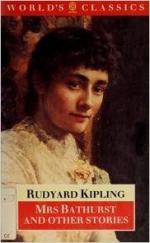|
This section contains 216 words (approx. 1 page at 400 words per page) |

|
Mrs. Bathurst Summary & Study Guide Description
Mrs. Bathurst Summary & Study Guide includes comprehensive information and analysis to help you understand the book. This study guide contains the following sections:
This detailed literature summary also contains Bibliography on Mrs. Bathurst by Rudyard Kipling.
"Mrs. Bathurst" is perhaps Rudyard Kipling' most popular short story. Although his career began as a journalist, it is Kipling's prose sketches and verse that earned him widespread respect as an author at an early age. Henry James considered Kipling the most complete man of genius he had ever known. Authors such as T. S. Eliot and C. S. Lewis acknowledged his influence on their own work.
Kipling's reputation as an author, however, has been under almost constant revision in the twentieth century. Lionel Trilling perceived him as a mere curiosity of the past, a man whose conservative politics eclipsed his literary status. George Orwell was equally dismissive of Kipling. After receiving the Nobel Prize in literature in 1907, critics agree that Kipling's subsequent career suffered in comparison with the achievement of such early novels as Kim and the two volumes of The Jungle Book.
"Mrs. Bathurst" incorporates central aspects of Kipling's fiction, including his use of dialect, his complex structure of composition, and his fascination with the sea. The critical reception of the story was enthusiastically positive, though critics have been confused by certain elements. Nonetheless, the story has fascinated readers and critics alike for more than ninety years, and has been at the center of the debate concerning Kipling's reputation as an author.
Read more from the Study Guide
|
This section contains 216 words (approx. 1 page at 400 words per page) |

|



